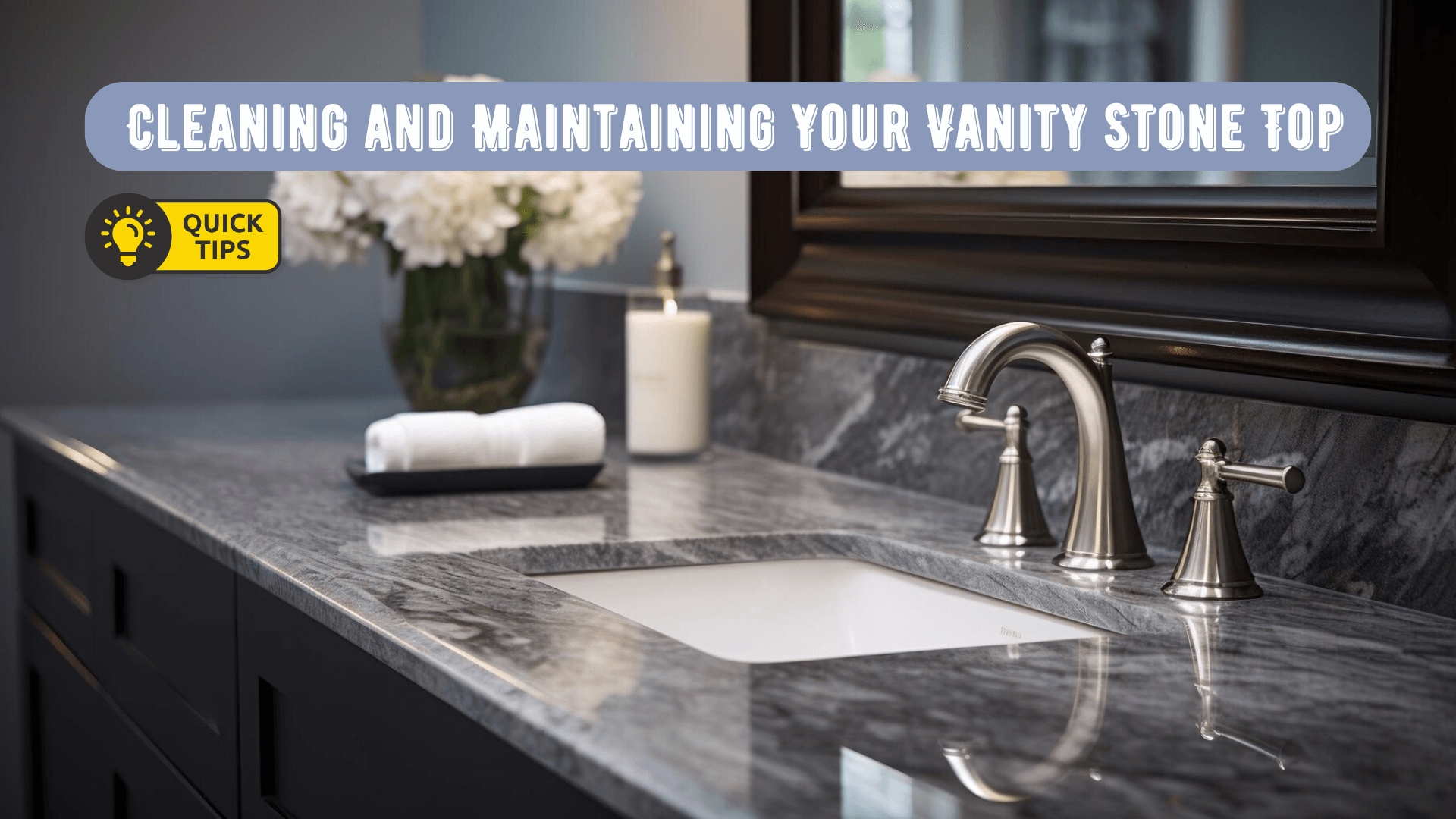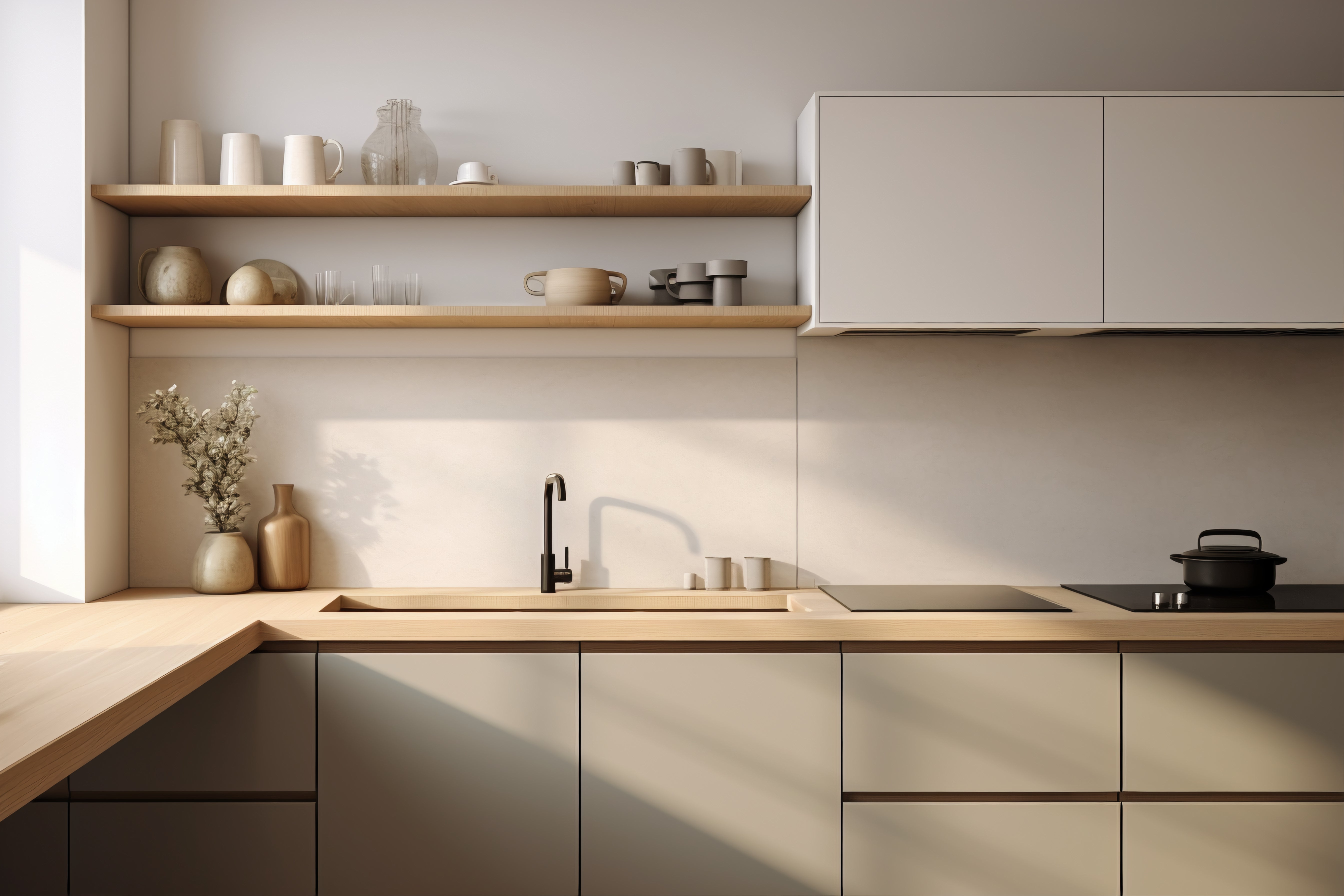
How to Clean and Maintain Your Vanity Stone Top
How to Clean and Maintain Your Vanity Stone Top is something every homeowner should know to keep their bathroom looking fresh and elegant. Vanity stone tops are not just stylish; they’re also a durable choice. However, without proper care, they can lose their shine, develop stains, or even get damaged over time.
The good news is that maintaining them doesn’t have to be complicated. With a little daily effort and the right cleaning techniques, you can keep your vanity stone top in perfect condition for years. In this blog, we’ll walk you through simple steps to clean your stone surface, tips to remove tough stains, and advice on protecting it from future damage. Whether your stone is marble, quartz, or granite, this guide will help you make it last longer and look as good as new. Let’s dive into the easy ways to care for your vanity!
Understanding Your Vanity Stone Top
Vanity stone tops are a popular choice in bathrooms due to their elegance and durability. These stone surfaces are made from various materials, each with unique characteristics that determine how you should care for them. The most common types of vanity stone tops are marble, granite, and quartz.
Marble is known for its luxurious appearance with its smooth texture and veining. However, it is porous and can absorb liquids, making it prone to stains and etching from acidic substances like lemon juice or cleaning products.

Granite is a hard and durable natural stone. It resists scratches and heat but still requires sealing to protect it from stains. It’s an excellent choice for high-traffic bathrooms because of its sturdiness.
Quartz is an engineered stone made from natural quartz mixed with resins and pigments. It is non-porous, meaning it resists stains and doesn’t require sealing. However, it can be sensitive to heat and harsh chemicals.
Understanding the material of your vanity top is essential because cleaning methods vary depending on the stone type. For example, you should avoid abrasive cleaners on marble, while quartz should not come into contact with bleach. By knowing the characteristics of your stone, you can choose the right products and methods to keep it in good condition. Whether you have a classic marble top or a low-maintenance quartz surface, proper care will ensure it remains a centerpiece in your bathroom for years.
Why Cleaning and Maintenance Matter
Regular cleaning and maintenance of your vanity stone top are crucial for several reasons. First, these surfaces are often exposed to water, soap, makeup, and other substances that can cause stains or damage if not cleaned promptly. Without proper care, even the most durable stone can lose its shine and elegance over time.
One of the main reasons for maintaining your vanity stone top is to prevent stains. Many stones, like marble and granite, are porous, which means they can absorb liquids. When water, oil, or other substances seep into the stone, they leave behind unsightly marks that can be difficult to remove.

Another reason is to protect the surface from scratches and etching. Vanity tops are used daily, and improper cleaning tools or rough objects can cause small scratches that dull the finish. Acidic substances, such as vinegar or certain bathroom cleaners, can also etch the surface, especially on marble.
Proper maintenance extends the lifespan of your stone top. A well-maintained stone top can last for decades without needing replacement. Simple steps, like cleaning up spills immediately and using coasters or mats, can make a big difference.
Additionally, regular cleaning keeps the surface hygienic. Bathrooms are high-moisture environments, making them prone to bacteria and mold growth. Keeping your vanity top clean ensures it remains a healthy and safe surface for everyday use.
By taking time to clean and maintain your vanity stone top, you not only preserve its beauty but also protect your investment. Whether it’s a daily wipe-down or periodic sealing, consistent care will keep your bathroom looking luxurious and welcoming.
Daily Cleaning Tips
Daily cleaning is the easiest and most effective way to keep your vanity stone top looking like new. It doesn’t take much time, and a simple routine can prevent stains, scratches, and other issues from building up. Here’s how you can clean your vanity stone top daily.
Start with Dusting or Wiping Down
Use a soft, dry microfiber cloth to remove dust, hair, or debris from the surface. This prevents particles from scratching the stone when you clean it.
Use a Gentle Cleaner
Mix a few drops of mild dish soap with warm water in a spray bottle. Spray the solution onto the surface and wipe it down with a soft, damp cloth. Avoid using harsh or acidic cleaners as they can damage the stone.
Dry the Surface
After cleaning, use a dry microfiber cloth to wipe the surface. Leaving water to sit can lead to water stains, especially on porous stones like marble.
Pay Attention to High-Touch Areas
Spots near the sink or corners often accumulate more dirt and grime. Give these areas a little extra care during your daily cleaning.
Avoid Overloading the Surface
Keep your vanity top clear of clutter. Heavy or sharp objects can scratch the surface, so use trays or organizers to store items like makeup, lotions, and soap dispensers.
Daily cleaning not only keeps your vanity looking clean but also prevents long-term damage. It’s a small effort that goes a long way in maintaining the beauty and durability of your stone top. If you clean your surface regularly, it will be easier to handle deeper cleaning or tough stains later.
Removing Stains Effectively
No matter how careful you are, stains can still happen. Whether it’s water rings, makeup spills, or soap scum, knowing how to remove stains effectively will help keep your vanity stone top spotless.
Identify the Type of Stain
Different stains require different treatments. For example, oil-based stains from makeup or lotions need a degreasing agent, while water stains can often be removed with simple techniques like polishing.
Blot, Don’t Rub
When a spill occurs, blot it immediately with a soft cloth or paper towel. Rubbing the stain can push it deeper into the stone, making it harder to remove.
Use a Baking Soda Paste for Tough Stains
Mix baking soda with water to form a paste. Apply it to the stain, cover it with plastic wrap, and let it sit for a few hours or overnight. Wipe it off with a damp cloth and dry the surface. This method works well for removing organic stains on marble or granite.
Try a Stone-Safe Stain Remover
For stubborn stains, use a cleaner specifically designed for stone surfaces. Make sure the product matches your stone type to avoid damage.
Avoid Abrasive Tools
Never use steel wool or scouring pads on your vanity stone top. These tools can leave scratches that are difficult to repair.
Seal the Surface Regularly
If your stone is porous, applying a sealant will make it more resistant to stains. Be sure to reapply the sealant as recommended by the manufacturer.
Removing stains can be straightforward if you act quickly and use the right methods. By staying on top of spills and protecting the surface, you can ensure your vanity stone top remains clean and beautiful.
Protecting the Surface
Protecting your vanity stone top is just as important as cleaning it. While stone is durable, it is not invincible. Daily use, spills, and harsh products can lead to scratches, stains, and even permanent damage. Taking proactive steps to protect the surface can help maintain its beauty and functionality for years.
Seal Your Stone Top
For porous stones like marble and granite, sealing is a must. A sealant acts as a protective barrier, preventing liquids from seeping into the stone and causing stains. Sealants are easy to apply and should be reapplied every 6–12 months, depending on the usage and the manufacturer’s instructions.
Use Coasters and Trays
Place coasters under bottles of lotions, soaps, or any items that might leak. Use decorative trays to organize and protect areas where products are frequently used. This keeps your vanity looking neat while shielding the stone.
Avoid Heavy or Sharp Objects
Don’t place heavy objects or sharp tools directly on the vanity stone top. These can scratch or chip the surface. Use padding or mats under heavy items if necessary.
Wipe Spills Immediately
Liquids like water, oils, or acidic substances can damage stone surfaces if left unattended. Make it a habit to wipe spills as soon as they happen, using a soft cloth or paper towel.
Protect from Heat
Although some stones like granite are heat-resistant, it’s best to avoid placing hot tools like curling irons directly on the surface. Use heat-resistant mats or trivets for added protection.
Protecting your vanity stone top doesn’t take much effort but goes a long way in keeping it looking flawless. By following these simple steps, you can prevent damage and enjoy your beautiful bathroom surface for many years.
Avoiding Common Mistakes
While maintaining a vanity stone top seems simple, there are several common mistakes that can cause unintended damage. Knowing what to avoid ensures your stone surface stays in excellent condition.
Using Harsh Cleaning Products
Many people assume all-purpose cleaners are safe for stone, but that’s not true. Avoid products containing bleach, vinegar, or ammonia, as these can strip the sealant and damage the stone’s finish. Always opt for pH-neutral cleaners designed for stone surfaces.
Scrubbing with Abrasive Tools
Never use steel wool, scrubbing pads, or hard brushes on your vanity stone top. These can leave scratches that dull the surface and make it more vulnerable to staining. Stick to soft microfiber cloths or sponges.
Neglecting Regular Sealing
If your stone requires sealing, skipping this step can lead to water absorption, staining, and long-term damage. Reapply sealant regularly to maintain the stone’s protective layer.
Allowing Spills to Sit
Leaving spills, especially from acidic substances like citrus juice, wine, or makeup, can cause etching or permanent stains. Always clean spills immediately to prevent damage.
Overloading the Surface
Placing too many heavy or sharp objects on your vanity stone top can lead to scratches, cracks, or even breakage. Use organizers and avoid dragging items across the surface.
Ignoring Manufacturer Recommendations
Each stone type has specific care needs. Following general advice without considering your stone’s unique characteristics can result in damage. Always refer to the care instructions provided by the manufacturer.
Avoiding these common mistakes ensures your vanity stone top remains in top condition. By using the right products, tools, and techniques, you can maintain its beauty and functionality with minimal effort.
Long-Term Maintenance
While daily cleaning and immediate care are essential, long-term maintenance is what ensures your vanity stone top stands the test of time. Periodic deep cleaning, sealing, and professional care can significantly extend the life of your stone surface.
Regular Deep Cleaning
Over time, soap scum, watermarks, and grime can build up on your vanity stone top, even with daily cleaning. Use a stone-safe cleaner or make a solution of mild dish soap and warm water. Apply it to the surface, let it sit for a few minutes, and then wipe it off with a soft cloth. Rinse thoroughly and dry with a clean microfiber towel.
Reapplying Sealant
Most stone surfaces require resealing every 6–12 months. To check if your vanity needs resealing, pour a small amount of water on the surface. If it absorbs quickly, it’s time to reseal. Follow the product instructions carefully to ensure proper application.
Polishing the Surface
Polishing can restore the shine of your vanity stone top, especially if it looks dull over time. Use a polish specifically designed for your stone type. Polishing also provides an extra layer of protection.
Professional Care
For tough stains, chips, or cracks, consider hiring a professional stone care expert. They can provide specialized cleaning, repair, and restoration services to make your stone look brand new.
Inspect Regularly
Look for signs of wear, such as dullness, scratches, or watermarks. Addressing small issues early prevents bigger problems later.
Long-term maintenance doesn’t have to be overwhelming. By setting aside time for periodic care and addressing issues promptly, you can enjoy a beautiful and durable vanity stone top for decades.
Tips for Different Stone Types
Different stone types have unique properties, and understanding these is essential for proper care. Here are specific tips for maintaining marble, granite, quartz, and engineered stones:
Marble
- Marble is porous and prone to etching. Avoid acidic cleaners and substances like lemon juice or vinegar.
- Use a soft, damp cloth with a pH-neutral cleaner for daily cleaning.
- Always blot spills immediately to prevent stains.
- Seal marble every 6–12 months to protect against water and oil stains.
- Granite
- Granite is more durable but still needs sealing. Reapply sealant annually to maintain its resistance to stains.
- Use mild dish soap and warm water for cleaning. Avoid abrasive tools.
- Protect it from heavy impact to prevent chipping.
- Regularly inspect for scratches or dull spots and polish as needed.
Quartz
- Quartz is non-porous and doesn’t need sealing, making it low-maintenance.
- Clean with a soft cloth and gentle cleaner. Avoid bleach or harsh chemicals.
- Although heat-resistant, it’s best to use trivets for hot tools to prevent discoloration.
- Don’t expose quartz to prolonged sunlight, as it can fade over time.
- Engineered Stones
- Similar to quartz, engineered stones are non-porous and easy to maintain.
- Clean with water and mild soap. Avoid harsh chemicals.
- Use cutting boards to prevent scratches from sharp objects.
- Avoid placing heavy or sharp items directly on the surface.
By tailoring your care routine to the specific stone type, you ensure it remains in excellent condition. Each material has its strengths and weaknesses, so a little extra attention goes a long way in preserving its beauty.
Conclusion
Maintaining your vanity stone top doesn’t have to be complicated. By following simple cleaning routines, using the right products, and protecting the surface from daily wear, you can keep it looking stunning for years. Avoid common mistakes, understand the specific care needs of your stone type, and prioritize regular maintenance. With these tips, your vanity stone top will remain a durable and elegant feature in your bathroom for a long time.
FAQs
1. How often should I seal my vanity stone top?
It depends on the type of stone. For porous stones like marble and granite, sealing every 6–12 months is recommended. Non-porous stones like quartz typically don’t require sealing.
2. Can I use vinegar or bleach to clean my stone top?
No, vinegar, bleach, and other acidic or harsh cleaners can damage the stone’s finish and strip away the sealant. Always use a pH-neutral cleaner designed for stone surfaces.
3. How can I remove stubborn stains from my stone top?
For tough stains, use a stone-safe poultice or a cleaner recommended by the manufacturer. Avoid scrubbing with abrasive tools, as they can scratch the surface.
4. Is it safe to place hot tools like curling irons directly on the stone top?
Even heat-resistant stones like granite can be damaged by prolonged exposure to heat. Always use a heat-resistant mat or trivet to protect the surface.
5. What should I do if my stone top gets scratched or chipped?
Minor scratches can sometimes be buffed out using a polishing product. For deep scratches or chips, it’s best to consult a professional stone care expert for repair.




